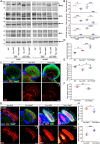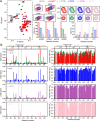Specific binding of Hsp27 and phosphorylated Tau mitigates abnormal Tau aggregation-induced pathology
- PMID: 36048712
- PMCID: PMC9436411
- DOI: 10.7554/eLife.79898
Specific binding of Hsp27 and phosphorylated Tau mitigates abnormal Tau aggregation-induced pathology
Abstract
Amyloid aggregation of phosphorylated Tau (pTau) into neurofibrillary tangles is closely associated with Alzheimer's disease (AD). Several molecular chaperones have been reported to bind Tau and impede its pathological aggregation. Recent findings of elevated levels of Hsp27 in the brains of patients with AD suggested its important role in pTau pathology. However, the molecular mechanism of Hsp27 in pTau aggregation remains poorly understood. Here, we show that Hsp27 partially co-localizes with pTau tangles in the brains of patients with AD. Notably, phosphorylation of Tau by microtubule affinity regulating kinase 2 (MARK2), dramatically enhances the binding affinity of Hsp27 to Tau. Moreover, Hsp27 efficiently prevents pTau fibrillation in vitro and mitigates neuropathology of pTau aggregation in a Drosophila tauopathy model. Further mechanistic study reveals that Hsp27 employs its N-terminal domain to directly interact with multiple phosphorylation sites of pTau for specific binding. Our work provides the structural basis for the specific recognition of Hsp27 to pathogenic pTau, and highlights the important role of Hsp27 in preventing abnormal aggregation and pathology of pTau in AD.
Keywords: Alzheimer's disease; E. coli; Hsp27; biochemistry; chaperone; chemical biology; human; phosphorylated Tau; tauopathy.
© 2022, Zhang, Zhu, Lu et al.
Conflict of interest statement
SZ, YZ, JL, ZL, AL, WZ, JL, JQ, SZ, YZ, CL, JL, ZH, RZ, DL No competing interests declared
Figures











Similar articles
-
Nicotinamide mononucleotide adenylyltransferase uses its NAD+ substrate-binding site to chaperone phosphorylated Tau.Elife. 2020 Apr 6;9:e51859. doi: 10.7554/eLife.51859. Elife. 2020. PMID: 32250733 Free PMC article.
-
Small heat shock proteins Hsp27 or alphaB-crystallin and the protein components of neurofibrillary tangles: tau and neurofilaments.J Neurosci Res. 2008 May 1;86(6):1343-52. doi: 10.1002/jnr.21589. J Neurosci Res. 2008. PMID: 18061943
-
Tau phosphorylation, molecular chaperones, and ubiquitin E3 ligase: clinical relevance in Alzheimer's disease.J Alzheimers Dis. 2015;43(2):341-61. doi: 10.3233/JAD-140933. J Alzheimers Dis. 2015. PMID: 25096626 Review.
-
Hsp90 regulates tau pathology through co-chaperone complexes in Alzheimer's disease.Prog Neurobiol. 2011 Jan;93(1):99-110. doi: 10.1016/j.pneurobio.2010.10.006. Epub 2010 Nov 5. Prog Neurobiol. 2011. PMID: 21056617 Review.
-
Cellular factors modulating the mechanism of tau protein aggregation.Cell Mol Life Sci. 2015 May;72(10):1863-79. doi: 10.1007/s00018-015-1839-9. Epub 2015 Feb 11. Cell Mol Life Sci. 2015. PMID: 25666877 Free PMC article. Review.
Cited by
-
Understanding chaperone specificity: evidence for a 'client code'.Trends Biochem Sci. 2023 Aug;48(8):662-664. doi: 10.1016/j.tibs.2023.05.008. Epub 2023 Jun 15. Trends Biochem Sci. 2023. PMID: 37328388 Free PMC article.
-
CDK5-mediated hyperphosphorylation of Tau217 impairs neuronal synaptic structure and exacerbates cognitive impairment in Alzheimer's disease.Transl Psychiatry. 2025 Aug 21;15(1):302. doi: 10.1038/s41398-025-03551-9. Transl Psychiatry. 2025. PMID: 40841523 Free PMC article.
-
Capturing the Conformational Heterogeneity of HSPB1 Chaperone Oligomers at Atomic Resolution.J Am Chem Soc. 2025 May 7;147(18):15181-15194. doi: 10.1021/jacs.4c18668. Epub 2025 Mar 27. J Am Chem Soc. 2025. PMID: 40146081 Free PMC article.
-
Identification of Alzheimer's disease biomarkers and their immune function characterization.Arch Med Sci. 2024 Jun 7;21(1):233-257. doi: 10.5114/aoms/188721. eCollection 2025. Arch Med Sci. 2024. PMID: 40190307 Free PMC article.
-
The heat shock protein Hsp27 controls mitochondrial function by modulating ceramide generation.Cell Rep. 2023 Sep 26;42(9):113081. doi: 10.1016/j.celrep.2023.113081. Epub 2023 Sep 8. Cell Rep. 2023. PMID: 37689067 Free PMC article.
References
-
- Abisambra JF, Blair LJ, Hill SE, Jones JR, Kraft C, Rogers J, Koren J, Jinwal UK, Lawson L, Johnson AG, Wilcock D, O’Leary JC, Jansen-West K, Muschol M, Golde TE, Weeber EJ, Banko J, Dickey CA. Phosphorylation dynamics regulate hsp27-mediated rescue of neuronal plasticity deficits in tau transgenic mice. The Journal of Neuroscience. 2010;30:15374–15382. doi: 10.1523/JNEUROSCI.3155-10.2010. - DOI - PMC - PubMed
-
- Ando K, Maruko-Otake A, Ohtake Y, Hayashishita M, Sekiya M, Iijima KM. Stabilization of microtubule-unbound tau via tau phosphorylation at ser262/356 by par-1/MARK contributes to augmentation of AD-related phosphorylation and aβ42-induced tau toxicity. PLOS Genetics. 2016;12:e1005917. doi: 10.1371/journal.pgen.1005917. - DOI - PMC - PubMed
MeSH terms
Substances
Grants and funding
LinkOut - more resources
Full Text Sources
Medical
Molecular Biology Databases
Research Materials
Miscellaneous

